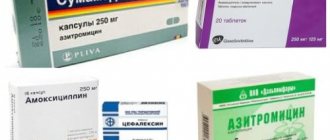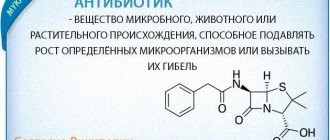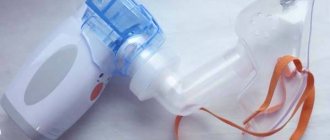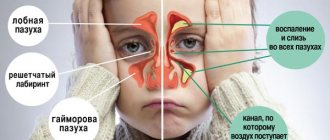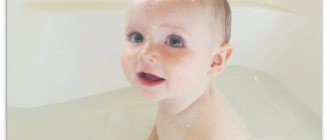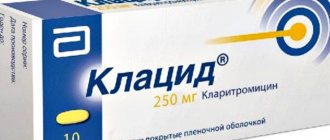What antibiotics to treat runny nose and cough in children
A common case is that parents begin immediate treatment with antibiotics at the slightest symptoms of rhinitis or influenza diseases. The choice of such therapy is not advisable and can lead to various types of complications, destruction of intestinal microflora, and negative effects on the cardiovascular system.
Additional symptoms
- Coughing attacks.
- Difficulty in removing mucus.
- Pain in the nasopharynx and throat.
- Temperature.
- Constant shortness of breath.
- Regular or persistent nasal congestion.
Start of therapy
The presence of a cough and runny nose in a child most likely indicates a cold (flu, ARVI). Infection with these viral diseases can occur due to hypothermia or reduced immunity. In this case, antibacterial drugs are completely useless. It must be taken into account that taking antibiotics has its consequences, since the drugs destroy both the pathogenic and beneficial bacterial environment. Not all medications are approved for children, and their uncontrolled use inevitably leads to nausea, diarrhea, and diarrhea. Plus, addiction can develop and in the case when taking an antibiotic is really necessary, you will not get the desired effect.
First, take your child to the doctor, tell the specialist about the runny nose, the absence or presence of fever and other symptoms. After a thorough examination, the doctor will prescribe adequate treatment. Most often, the doctor prescribes medications like Interferon, that is, they strengthen the immune system and have an antiviral effect. If the discharge changes its color to a darker or greenish color, and the cough intensifies, perhaps the cause of the illness is indeed bacterial in nature. Breathing becomes difficult, general weakness and sweating appear. In this case, therapy requires the use of antibiotics, but choosing them is a rather complex procedure that should not be carried out independently. The accuracy of the diagnosis depends on diagnostic measures; bacterial involvement is determined using bacterial culture.
If you notice that the child’s body is weakening, provide the child with a separate room (previously ventilated) and bed rest. The air (especially for children under 2 years old) should not be too dry, warm or cold (humidity up to 60% and temperature no more than 22 degrees). Try to monitor your diet during illness, so as not to overload the body, follow the drinking regime (at least 1.5 liters of clean water per day, or teas with lemon balm, raspberries, honey).
Not recommended actions
It is necessary to avoid stereotypes about treatment; just because a drug helped you, this does not mean at all that it will help your child. Children's medications act more loyally and do not have such a negative effect on the body. The following antibiotics should not be given to children:
- tetracycline type (destroy teeth);
- chloramphenicol (interferes with normal blood circulation);
- fluoridated type (promotes fragility of joints and cartilage).
You should not change the time you take medications or interrupt treatment. The concentration of antibiotics in the blood should not exceed acceptable standards. An infection that is not completely eliminated may become more resistant and begin to progress with greater force.
Choice of medications
As mentioned earlier, antibiotics should be selected by a specialist. The price of tablets does not determine their quality. For the little ones, candles, syrups and suspensions are recommended. After age 4, medications can be taken orally in tablet form. Severe pathologies and advanced diseases require intravenous administration of antibacterial agents. If certain tablets are ineffective, you should consult a pediatrician and change the pharmacy product to another.
Indications and contraindications
The considered methods of therapy and prescription are absolutely necessary for:
- inflammatory processes in the respiratory system (pneumonia);
- tuberculosis;
- purulent tracheitis;
- bacterial lesions of the bronchi.
Pay attention to possible side effects, contraindications and allergic reactions. Consider the child’s age, weight, and individual characteristics. If, after the first dose taken, redness of the skin, itching, or increased heart rate begin, immediately stop further manipulation. Ailments not listed above cannot be treated with antibacterial agents.
List of antibiotics
It is not possible to make a clear choice of any medication. It all depends on the type of harmful microorganisms and the duration of their stay in the body. The most common following groups of drugs:
- penicillin - available, but not always effective (modern sources of infection are resistant), representatives: Augmentin, Flemoxin, penicillin;
- cephalosporin - prescribed if there is insufficient exposure to previous representatives, the most well-known medication from this group is Cefuroxime;
- macrolide - can be prescribed for children from 1 year of age, this includes: Erythromycin, Azithrocycin and others similar in composition;
- fluoroquinol - not recommended for children, causes many complications.
According to doctors, it is best to treat a child’s body with syrups (Bronhollitin), they are quickly absorbed and have a pleasant taste, which will greatly facilitate the administration procedure.
Restoration of microflora
Dysbiosis may develop as a result of taking antibiotics. The main symptoms are diarrhea, rashes, dry mucous membranes and vomiting. To eliminate deviations, you must take Linex or Bifidumbacterin (there are age restrictions, read the instructions).
In addition, try to give your baby more fermented milk products with a low fat content. Vegetables, fruits, and therapeutic exercises will not be superfluous.
prootit.ru
General rules for taking antibiotics
Antibiotics for severe coughs in children quickly destroy the microbial flora, which leads to the disappearance of many symptoms of acute respiratory infections - sore throat, discomfort when swallowing, fever. But in order to achieve recovery, you need to follow medical recommendations.
General rules for antibacterial therapy:
- Only a doctor can choose the appropriate drug; improper treatment is dangerous for bacteria to develop resistance to the antibiotic;
- antimicrobial drugs can be given to the child only at regular intervals - once every 8, 12 or 24 hours;
- the minimum course of therapy is 5 days;
- antibiotics should not be taken for more than 2 weeks, as this is dangerous due to decreased immunity and mucosal candidiasis;
- During treatment, you need to drink probiotics to prevent disruption of intestinal microflora.
Before starting the course, you should read the instructions and contraindications for taking tablets or suspensions.
Rules for inhalation therapy:
- The session is scheduled 1.5 hours after eating;
- if the bronchi, trachea and lungs are affected, the aerosol is inhaled and exhaled through the mouth;
- in case of inflammation of the nasopharynx, breathe superficially only through the nose;
- do not take mucolytic medications within 1.5 hours after inhalation;
- half an hour after the procedure, do not go outside and do not eat food.
If inhalation therapy is carried out with drugs from different groups, they are used in a certain sequence.
First, inhalations are done with mucolytics, then with anti-inflammatory drugs, and at the very end with antibiotics. Antibiotics are a separate group of medications that are used to destroy microbial flora. They are used to combat cough only in the case of a bacterial infection, represented by staphylococci, Pseudomonas aeruginosa, pneumococci, streptococci and other pathogens.
source
Antibiotic for coughs for children: how to choose from the abundance of options?
A child’s cough is always a headache for the mother, especially if it is accompanied by a runny nose and fever. As a rule, the doctor does not carry out antibiotic therapy immediately, observing the development of the infection.
But if the baby gets worse, the temperature does not subside, and wheezing is heard when listening to breathing, an antibiotic for coughing for children is prescribed.
There are several groups of drugs:
- Penicillin group. These drugs are prescribed for persistent severe cough in children. They cause the least harm to the body, since the main active ingredient affects only the walls of bacteria. The list can include names such as Amoxiclav, Amoxicillin, Augmentin, etc.
- A group of macrolide drugs. They stop the process of bacterial reproduction and destroy proteins in pathogen cells. These include Sumamed, Hemomycin, Macropen, Aksetin, etc.
- Group of cephalosporins. These drugs inhibit the growth and reproduction of infectious agents by damaging their cell membranes. The names of children's products include Suprax, Cefazolin, Ixim, Tsifaleksin, etc.
A broad-spectrum drug based on amoxicillin. As you know, penicillin has been used for decades, so during this time many bacteria have developed resistance to it. Its effect is enhanced by clavulanic acid, which has its own antibacterial activity. This antibiotic can be in the form of powder for suspension and lyophilized powder for injection.
The latter is used in a hospital setting, and the tablets are not intended for children. Amoxiclav is active against many aerobic gram-positive and gram-negative bacteria and is easily tolerated by children, but the finished suspension cannot be stored in the refrigerator for longer than 7 days.
Instructions for use of syrup:
- For newborns and babies up to 3 months, the drug is given with a special measuring pipette or spoon at the rate of 30 mg of the drug for cough and fever per 1 kg of weight 2 times a day;
- for children over 90 days, the dose varies between 20-40 mg/kg, depending on the severity of the disease.
The maximum permissible daily dose of Amoxicillin, a pediatric antibiotic for dry cough, is 45 mg/kg body weight.
Contraindications include impaired liver function or cholestatic jaundice, which were previously observed when taking this pediatric antibiotic for cough. Treatment is not recommended for infectious mononucleosis and lymphocytic leukemia. The same applies to persons with hypersensitivity to the components of the drug and antibiotics of the penicillin group. Of course, the downside of the suspension is that it does not last long. But as practice shows, during treatment the baby manages to drink the entire bottle. This is very convenient, because small children are not yet able to swallow a tablet, and the liquid can be easily drunk.
Those who are interested in what antibiotic to give a child for a cough should pay attention to the drug, the main active ingredient of which is azithromycin dihydrate.
It is characterized by a wide spectrum of antimicrobial action, and the mechanism is the suppression of microbial protein synthesis. Under its influence, the growth and reproduction of pathogenic microorganisms, which include gram-positive and gram-negative bacteria, anaerobes, intracellular organisms, etc., slows down.
Summamed also comes in the form of tablets, capsules, powder for preparing a suspension, and lyophilisate for preparing a solution for droppers. For children with a cough and fever, this antibiotic is given in the form of a powder, diluted with water according to the instructions, using a syringe or measuring spoon.
Calculation of the drug when prescribed in the amount of 10 mg/kg:
- for children weighing 5 kg, the syrup dosage is 2.5 ml or 50 mg;
- 6 kg – 3 ml or 60 mg;
- 7 kg – 3.5 ml or 70 mg, etc. up to 10 kg.
This applies to children in the age group from six months to 3 years. For the age category from 3 to 12 years with a body weight less than 45 kg, the dosage is different. You can give antibiotic cough syrup to children at a rate of 10 mg/kg body weight. When deciding which antibiotics to give to children when they cough, you must remember that to obtain 20 ml of suspension, you need to add 12 ml of water to the powder and shake well.
The finished composition is also not stored in the refrigerator for a long time and this is its disadvantage, but Summamed also has one undeniable advantage - it is given only once a day an hour before or 2 hours after a meal, and the course of treatment is within 3 days, although In some cases, the doctor may extend it to 5 days.
Contraindications include hypersensitivity to the components of the drug and macrolide antibiotics. This name of the drug for children should be blacklisted by those parents whose children suffer from severe disorders of the liver and kidneys or have not reached the age of 6 months. You cannot treat with this drug if you have a severe cough together with Ergotamine and Dihydroergotamine.
What other means can be given?
Suprax is a semi-synthetic cephalosporin antibiotic.
The main active ingredient is cefixime, which inhibits the main component of the cell wall of the pathogenic microorganism. This is a new generation drug that is resistant to beta-lactomases.
We are talking about bacterial enzymes that can destroy the antibiotic and make it ineffective. The medicine kills various streptococci, E. coli, Proteus, salmonella, gonococci, staphylococci, etc.
This antibiotic, prescribed for coughs, can be in the form of capsules or granules for suspension. The latter are prescribed to children aged from 6 months to 12 years.
Treatment is carried out according to the following instructions:
- for children from 6 months to a year, the product is given 2.5-4 ml;
- in the age category from 2 to 4 years, the dose of syrup is increased to 5 ml;
- from 5 to 11 years it is 6-10 ml.
When thinking about which antibiotic to choose for a cough, you should remember that Suprax is diluted with 40 ml of cool water in 2 stages, shaking the contents of the bottle well each time. It is prescribed for severe cough and runny nose, no matter whether dry or wet. It is important that it is able to cope with fairly aggressive pathogens. It is also often used in step therapy, starting treatment with 3rd generation cephalosporins and ending with a drug called Suprax.
Contraindications include intolerance to the components of the drug and antibiotics of the cephalosporin and penicillin group. Use with caution in babies with chronic renal failure and do not give to children under 6 months.
Now it has become more or less clear which drug is best to give to a child for a dry or wet cough. But in any case, given the harm it can cause to the body, it is better to first consult a doctor.
prostudynet.ru
What drugs are prescribed by age (up to one year, up to three, up to 7 years, up to 10)
Children up to one year old are prescribed antibiotics made in suspensions. This form is the most suitable, since the swallowing reflex in babies is poorly developed. To prepare the solution, take a syringe with a measuring division. As a rule, it comes with the medicine. And they put 12 ml into it. boiled water. Add to tablet or suspension mixture and shake well. Store in the refrigerator for no more than 5 days between doses.
From birth, until the baby is one year old, it is allowed to give penicillin antibiotics, since they have little toxicity. They can be used for scarlet fever, tonsillitis, skin infections, acute sinusitis, otitis media.
For example, Amoxicillin can be used up to 5 years of age. One measuring spoon contains 5 milliliters of suspension and 250 milligrams of amoxicillin. Dosage for children under 2 years of age – no more than 20 mg/kg/day. Amoxicillin is used alone or in combination with clavulanic acid.
Augmentin has a wide range of applications. For newborn babies, the dosage should be carried out strictly according to the instructions. You can also give Amoxiclav for up to a year.
Macropen, Azithromycin and Sumamed are available in tablet form, so they are suitable for treating older children. From the age of three it is quite possible to prescribe them. Isofra, EcoClav, Polydexa are prescribed to children from three to seven years old. Ospamox, Meronem, Klabax are allowed to be given to children under 10 years of age.
We recommend: Derinat for children instructions
Antibiotics for children with cough and runny nose
Cough and runny nose - just stop by the children's clinic at the height of the season of colds and viral diseases. An incessant “symphony” of wet and dry coughs and many small snotty noses - unfortunately, children are especially susceptible to such ailments. And the saddest thing is that mothers are not always able to cure toddlers without antibiotics. Today we will talk about when to give antibiotics to a child for a cough and runny nose, or more precisely, when this measure is justified, and when it is worth abstaining.
Antibiotics for severe cough in children
Many mothers will consider a strong, debilitating cough in their baby as a reason to resort to antibacterial therapy. However, this is not always advisable. For example, when a cough is accompanied by a fever that lasts no more than 3 days, redness in the throat, runny nose and general malaise, hasty measures in the form of antibiotics can only be harmful. The fact is that such symptoms most often indicate a viral etiology of the disease, and as you know, antibacterial drugs are powerless against viruses. If the patient’s condition worsens: the temperature does not drop, weakness appears, shortness of breath, breathing becomes difficult, then there is reason to believe that a bacterial process has begun in the respiratory system: bronchitis, pneumonia, tracheitis. That is, with a severe cough in children, antibiotics are prescribed only if other symptoms characteristic of a bacterial connection are present. Here is the basic list of antibiotics for children with cough:
- Penicillins. Drugs of this group (Augmentin, Amoxilav, Flemoxin) are often used as emergency first aid. They have a fairly wide spectrum of action and a minimum of side effects. It is worth remembering that penicillins will not have the desired effect for pneumonia.
- Cephalosporins. Stronger drugs (Cefuroxime, Cefix, Cefazolin) are prescribed when secondary therapy is necessary (for example, if a couple of months ago the child was already taking antibiotics or drugs of the penicillin group were not suitable for him).
- Macrolides. This is a kind of heavy artillery that is used for inflammation of the respiratory tract (Azithromycin, Clarithromycin, Sumamed).
- In exceptional cases, fluoroquinolones are prescribed to children.
If a child’s cough does not go away after taking antibiotics, it can be assumed that the drug was chosen incorrectly for the baby. Also, in some cases, an allergic reaction is likely to develop.
It is worth remembering that only a doctor should prescribe antibiotics for children with a cough and runny nose, ideally after taking a sputum culture and identifying the causative agent. But since this takes quite a long time, in most cases pediatricians prescribe systemic drugs with a wide spectrum of action, taking into account the child’s age, his weight and the likely pathogen.
Antibiotics for a runny nose in a child
Oddly enough, a common runny nose can also be a reason to take antibacterial drugs. Of course, if a runny nose is just one of the symptoms of a disease caused by bacteria, there is no doubt about the need for therapy. But when rhinitis occurs as an independent disease, many mothers, and even doctors, doubt the need for such treatment.
Basically, antibiotics for a runny nose in a child are prescribed in the following cases:
- development of chronic rhinitis;
- spread of inflammation to the sinuses;
- the appearance of green discharge.
Most often, drops or sprays for the common cold with an antibiotic are used to treat children. They have a local effect, relieve inflammation in the nasal sinuses, destroying the bacteria that provoked it.
In conclusion, it is worth noting that before giving antibiotics to children with a runny nose and cough, you need to thoroughly weigh the pros and cons. Indeed, in addition to their main purpose, such drugs have a detrimental effect on the biocenosis of the body as a whole, making it susceptible and vulnerable, especially at first.
Related articles:
| Mustard plasters for coughs in children Mustard plasters have always been considered an effective remedy in the treatment of colds, coughs and runny noses. They are especially often used in the treatment of children. How exactly and at what age you can use them for coughing - read on. | Antibiotics for colds in children Today, more and more often, seemingly banal acute respiratory viral infections cause complications in the form of a bacterial infection, which significantly aggravates the course of the disease and the patient’s condition. Therefore, pediatricians often use heavy artillery - antibiotics, so disliked by parents. |
| Turpentine cough ointment for children Turpentine ointment can have a powerful antiseptic, anti-inflammatory and warming effect. It is this selection of valuable qualities that allows it to be used in the fight against cough even in children. Next, we will discuss how to properly use the ointment when treating children. | Antibiotics for bronchitis in children - names Bronchitis is a common complication of respiratory diseases in children, and if it is caused by a bacterial infection, then it is necessary to use antibiotics. Next, let's talk about the most common of them. |
womanadvice.ru
What antibiotics can a doctor prescribe for a cough?
It is best if, before choosing a drug, the doctor receives the results of a bacteriological examination of sputum and a smear from the child’s larynx and nose. Then the specialist will know for sure which bacteria caused the disease, and which antibiotic to “put in the line of fire” against them. But analysis of this kind is not carried out everywhere, and laboratory technicians take a long time to report the results - from 10 to 14 days. As we understand, neither the sick child, nor his concerned parents, nor the doctor have these two weeks. Therefore, doctors try to prescribe new generation broad-spectrum antibiotics for children who cough.
To treat cough, monotherapy is usually chosen - that is, one, usually relatively weak, antibiotic is used. If there is no improvement within 4-5 days, the doctor will change the drug to a more potent and effective one. The doctor will prescribe a stronger antibiotic (for example, from the cephalosporin group) even if the child has recently been treated with weaker antibiotics (for example, penicillin).
For children from birth to 3-4 years old, an antibiotic will be recommended in the form of a suspension, which is popularly mistakenly called “syrup” or in drops. Children from 5 to 10 years old can be given the medicine in tablets, and teenagers can take the medicine prescribed by the doctor in capsules.
For all ages, with severe disease, antibiotics can be prescribed in the form of injections - intramuscular or intravenous injections.
List of antibiotics most often prescribed to children for cough:
What antibiotics are most effective and safe for children?
Which antibiotics are safe for children? Perhaps every person asks this question. Doctors believe that the use of antibiotics when treating a child should only be done after consultation with a specialist. In some cases, it is not advisable to use antibiotics for children, as this can only worsen the course of the disease. Antibiotic medications can be available in the form of a suspension or tablets. In some cases, antibacterial drugs are administered by injection.
Antibiotics for colds
Antibiotics for children with colds are used only if the immune system is too weakened and cannot cope with the infection. If the patient has a red throat, fever, migraine and inflammation of the mucous membrane, broad-spectrum antibiotics may be needed. According to doctors, the best antibiotics for colds for children are Flemoxin, Solutab, Amoxiclav, Avelox and Moximac.
Before resorting to the use of antibacterial agents, treatment should be carried out with antiviral drugs. If more than 5 days have passed and medical therapy has not given the desired effect, the patient is prescribed antibacterial medications. The following drugs can be used to treat ARVI:
- Penicillins. These broad-spectrum drugs are often available in suspension or tablet form. The best drugs in this group are Augmentin and Ampicillin. These drugs are widely used in pediatrics because they have a low toxicity rate.
- Cephalosporins. Medicines in this group destroy the cell membrane of bacteria. Most often, antibacterial agents of the cephalosporin group are used to treat pleurisy and other complications of the common cold. In most cases, medications in this group are introduced into the body by injection. Please note that cephalosporins should not be used if the patient has kidney disease.
- Macrolides. It is advisable to use these antibiotics for children if the patient has atypical pneumonia. The best drug in this group is Erythromycin.
- Fluoroquinolones. These medications help destroy gram-negative bacteria. It is believed that fluoroquinolones are the safest drugs, as they have a low toxicity rate and virtually no side effects.
As a result of numerous studies, doctors have formed the names of the most dangerous antibacterial agents. For example, the list of dangerous drugs includes antibiotics of the tetracycline group. This is due to the fact that they interfere with the development of tooth enamel and bone tissue. In addition, numerous studies have shown that taking tetracycline medications by children aged 1 to 3 years can negatively affect the development of articular cartilage. In addition, Ofloxacin, Pefloxacin and Levomycetin are very dangerous antibacterial drugs.
Antibiotics for coughs
Antibiotics for children with coughs are a very effective remedy. For severe coughs that cannot be treated, doctors may prescribe special broad-spectrum antibiotics for children.
Before prescribing antibacterial medications, the physician must conduct a comprehensive diagnosis of the child. First of all, he must take a sputum culture test.
Children are usually prescribed syrups with antibiotics. These products are considered the most effective and harmless. A good antibiotic medicine is plantain syrup. This remedy helps get rid of cough after 3-5 days. This antibiotic for a child will speed up the removal of sputum from the bronchial mucosa. Please note that giving plantain syrup to children under 2 years of age is prohibited.
A good syrup for treating cough is Lazolvan. Treatment with this remedy is carried out only if inhalations and various medicinal tinctures do not help the child. Lazolvan helps the body create a protective flora in the bronchial mucosa, thereby destroying bacteria. This medication contains a strong antibiotic, which not only helps get rid of cough, but also reduces body temperature.
Broncholitin syrup is sometimes used to treat cough. This medicine is quite effective and has virtually no side effects. Note that the cough syrup contains herbal components, due to which the effect of the product is significantly enhanced. Note that Broncholitin contains a powerful antibiotic, so doctors recommend following the dosage of the medicine.
Another good antibiotic for coughs is Doctor Mom syrup. This medicine contains herbal ingredients. Doctors believe that when using Doctor Mom, drug therapy should be supplemented with other medications that are suitable for treating cough.
Antibiotics for a runny nose
For coughs and runny noses, antibiotic treatment is prescribed only if the disease is aggravated by the influence of pathogenic bacteria. In most cases, the child is prescribed drugs of the macrolide group. The best drugs in this group are Erythromycin and Clarithromycin.
If the patient has an inflammatory process in the nasal sinuses, treatment is carried out using local antibiotics. These drugs have virtually no side effects and do not harm the microflora of the nasal mucosa. Most often, topical antibiotics are available in the form of drops or spray. Note that drops and sprays are often sold in the form of a suspension with other solutions.
The list of the most effective medications includes Novoimanin nasal drops. This medication is able to fight gram-positive microbes that are resistant to penicillin. Before use, the drops are mixed with glucose or purified water.
You can also give your child Framycetin. These nasal drops are used for complex drug therapy of rhinitis or sinusitis. Note that the dosage of Framycetin will vary somewhat depending on the age of the patient.
The best nasal spray is Isofra. The active component of this medicine is framycetin. Drug therapy using Isofra lasts no more than 7-10 days.
Another good antibiotic spray is Bioparox. This medicine contains the polypeptide antibiotic fusafungin. This substance effectively fights gram-negative and gram-positive harmful microorganisms.
In conclusion, we note that antibiotics for a cold, cough or other illness should be prescribed exclusively by the attending physician.
Self-medication can lead to the development of numerous complications or even death. Before prescribing a specific medicine, the doctor must familiarize himself with the patient’s medical history and take into account his individual characteristics.
ladyinlife.ru
Medicines for treating cough
The modern pharmacological industry produces a huge number of different antimicrobial agents. To relieve cough, runny nose and other signs of bronchitis, the following groups of antibiotics are mainly used:
- Penicillins. They have pronounced effectiveness and fairly high safety. These medications are used in the treatment of diseases of the bronchopulmonary system in children of any age. For the treatment of children, a suspension based on amoxicillin, which includes Flemoxin Solutab, Amoxin and other drugs, is best suited. Very often, doctors use combination drugs that contain not only amoxicillin, but also clavulanic acid. The main representatives are Augmentin, Amoxiclav, Flemoclav Solutab, etc. These drugs are available in the form of syrup, tablets and injection solution.
- Cephalosporins. Prescribed when penicillins are ineffective. In the treatment of cough, cephalosporins of 2 or 3 generations are mainly used. This depends on the severity of the disease and its duration. Cephalosporins are mainly produced in the form of injection solutions to achieve rapid therapeutic action. In addition, tablets and capsules are not as effective. This group of antibiotics includes Cefuroxime, Zinnat, Medaxone, Tercef and others.
- Macrolides. Used to treat patients who have an allergic reaction to penicillins. These include Azithromycin and Clarithromycin. Each has its own advantages and disadvantages, so only a doctor can choose a specific remedy for a patient. Azithromycin is characterized by high efficiency and a long period of action. Thanks to this, the product only needs to be taken once a day. The most popular representative is Sumamed. Clarithromycin is not recommended for use in children under 1 year of age. It has a fairly large number of contraindications for use. Trademarks of antimicrobial agents that include clarithromycin Klacid, Fromilid, Zentiva and others.
Cost of medicines for cough and runny nose
| Medicine | Image | Price |
| Framycetin | 200-300 rubles | |
| Isofra | 330 rubles | |
| Bioparox | 120-500 rubles | |
| Sumamed | 220-560 rubles | |
| Azithromycin | 80-100 rubles | |
| Ospamox | 250-800 rubles | |
| Biseptol | 35-110 rubles | |
| Flemoxin Solutab | 235-500 rubles | |
| Amoxil | 30-150 rubles | |
| Cefodox | 70-160 rubles | |
| Augmentin | 140 rubles |
Attention! Due to small features in the composition of drugs produced in different pharmaceutical companies and in different countries, the cost of the medicine may differ by 5-20%.
Long-term use of antibiotics is extremely dangerous for a child's body. It's not just about the possibility of overdose and side effects. The most dangerous condition with prolonged use of antiviral and antibacterial drugs in patients may become addictive, which will make it impossible to cure it in the future. Only a competent approach to treatment can quickly help the child and minimize the risk of complications in the remission stage.
source
